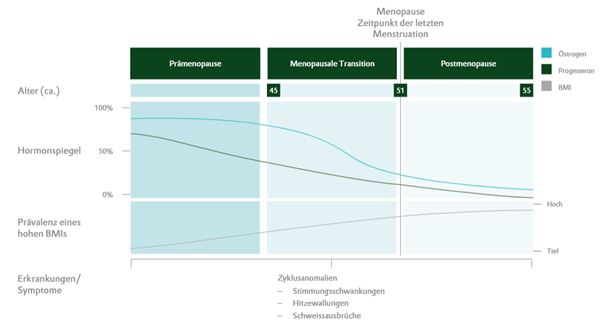Women's hearts beat differently!

Cardiovascular disease is also the biggest killer among women worldwide – and yet this silent threat is often underestimated. In Switzerland alone, almost one in three women is affected: cardiovascular disease is responsible for 28% of all deaths in this country. Out of a total of 20,110 people who died from cardiovascular disease, more than half (55%) were women.1
Despite these alarming figures, heart attacks in women are often not recognised – or even misinterpreted. Symptoms often differ from those experienced by men, which can lead to misdiagnosis or delayed treatment.
Anyone can be affected: cardiovascular disease is not necessarily a question of age. This makes it all the more important for women to be aware of their individual risk factors and family history.
The time during and after the menopause gets a lot of attention. Even though this phase of hormonal change does not cause heart disease itself, it does mark a turning point: blood pressure, cholesterol and metabolism change noticeably – and with these changes comes an increased risk.2
But there is good news!
Many heart attacks and strokes can be prevented – through knowledge, prevention and by taking proactive measures. These include:
- regular exercise
- a heart-healthy diet
- active stress relief
- measures aimed at boosting vascular function
- and systematic monitoring of blood pressure and blood sugar levels.
Because: heart health starts in everyday life – and affects us all.
[1] Swiss Federal Statistical Office; Cause of Death Statistics 2023
[2] American Heart Association, Go Red for Women
How do women's hearts "beat" differently?
Even though the heart is essentially the same in men and women, there are subtle but significant differences that have an impact on the risk of heart disease and symptoms.
For example, the female heart is significantly smaller on average – it weighs around 250 grams, whereas the male heart weighs around 100 grams more. This means that it pumps slightly less blood through the body per beat. The female body has a clever way of compensating for this: women's hearts simply beat faster. Whereas the average resting heart rate for men is around 60 beats per minute, for women it is around 70 beats per minute.3
But that's not all: the coronary arteries – the vessels that supply the heart itself with oxygen – also differ. In women, they are often smaller in diameter and more convoluted. This structure not only complicates diagnosis, but also affects how deposits (plaques) form, which can lead to coronary heart disease.
[3] NDR Visite; 20.05.2025; Ursula Stamm / Lucia Hennerici
A different view of heart attacks
For many people, a heart attack still conjures up the classic image: an older man with chest pain radiating into his left arm.
Women, however, often experience different symptoms, which is what makes the situation so challenging. They frequently report:
- back or shoulder pain
- nausea and vomiting
- shortness of breath or unusual tiredness
These non-specific signs are far too often downplayed or misinterpreted – and, as a result, valuable time is lost before treatment begins.
Oestrogen: protective shield for the female heart
When they're young, women have a natural advantage: the hormone oestrogen helps keep their hearts healthy in a bunch of ways:
- it promotes blood vessel elasticity,
- has an anti-inflammatory effect,
- and regulates cholesterol metabolism.
This protective shield protects many women from serious cardiovascular disease up until menopause. As oestrogen levels decline during menopause, however, the balance changes:
blood vessels lose elasticity, blood pressure rises, cholesterol levels can also go up, and the risk of heart attack and stroke increases significantly.

For precisely this reason, it is crucial to take targeted countermeasures during this phase of life – by adopting a heart-healthy lifestyle and, if necessary, by boosting normal vascular function, for example with cocoa flavanols.
Plant-based support with cocoa flavanols
In addition to lifestyle, nature can also be a valuable source of inspiration – for example, in the form of cocoa flavanols.
These secondary plant compounds are known for their vessel-protecting properties: they boost blood vessel elasticity and promote healthy endothelial function – which is especially important when the natural protection provided by oestrogen starts to fade.
PhytoCacao® Cardio provides 200 mg of cocoa flavanols daily in convenient tablet form.